20 October, 2004
Another cool day at the dive site.
Each time we go out, I get a better picture of what's happening under the ice. It's kind of strange not to be able to see the divers at work, but I'm learning a lot from what comes to the surface.
Today we returned to the Cinder Cones dive site to continue the work there. Because there is a lot of work to be done, most sites require several dives with as many as 6 people diving to accomplish everything. Before we left, the fuel sledge (see picture below) had to be attached to the Pisten Bully. It's a portable gas tank that gets dragged out to the dive hut to fill the fuel tanks that supply the stove that heats the hut.
Despite all the careful planning for the research here, everything doesn't always go according to plan. For example, the housing around the digital camera is leaking. To take a camera underwater, it must be either a special underwater camera that is sealed so water can't get in, or it must be enclosed in a watertight housing, often something that looks like a clear box. See pictures below of a housing and a Nikonos underwater camera. Unfortunately, the new housing for the digital camera is leaking in three places. This is very frustrating because the camera can't be used until that situation is resolved.
But there's still a lot to do: core samples to be taken, experiments to be be picked up, video footage to be recorded, a plankton sample to be collected, and an underwater fence to be removed.
Unlike the plankton tows that the students at Thompson do, and the plankton tow that Jennifer did at Cape Royds from the surface of the ice on Sunday, this plankton tow is done by the diver swimming and towing the net behind. There are a lot of things that the divers do that are a little bit awkward - sometimes very awkward - and they often need to find creative ways to get their jobs done. In order to get the core samples, one person may do the coring - actually pushing the "jar" (core ring) down into the sediment and then capping it and lifting the sample out. Another person floats over the first diver, carrying the racks of core rings and lids and passing them to the first diver as needed, then taking the full samples and placing them back in the rack. This is a lot harder than it sounds, because the person who's on top has to make sure to swim at just the right level - if they're too low, they squish the diver below, but if they swim too high, they're too far away to pas
s along the equipment.
Tomorrow, the divers will have an especially tricky job to do: they need to remove a long piece of plastic fencing - something like netting - that had been set up two years ago to enclose an experimental area. There was a lot of discussion about how this would be done. One thing for certain is that it can't come up through the dive hut hole, so it will need to go out through the safety hole, located about 25 meters away. This hole is made so that divers have a second way out of the water if, for some reason, the hole under the dive hut is blocked. One of the many challenges with this task is that the divers will have to swim over to the hole with the fencing, Then another challenge is to make it actually fit through the hole! Everybody had their own ideas about how it should be taken out, but I'm sure they'll come to some sort of agreement before they start trying it.
The water here is so clear that, standing over the dive hole, we could see sea stars down on the bottom in 60 feet of water. I tried to take a picture (see below), but it's difficult with the reflection off the surface of the water.
After the dive, we returned to the lab to sieve the core samples. While Stacy, Andrew, Jennifer and Mike sieved, I labeled bottles for the samples from each core. The dive site, date, and core number are written on the bottle lid, and the same information is written on a piece of waterproof paper that goes inside the bottle. The core number and amount of sediment in each core is recorded in the science notebook. (Yes, scientists really do keep science notebooks, just like 7th graders.)
In the evening, we went to two lectures. The first was by Dr. Mike Castellini, from the University of Alaska, who studies how Weddell seals digest their food. He has a research camp on the ice called "Fat City II" (90 percent of a seal's nutrition comes from fat), where he keeps seals. The seals go through a hole in the ice to feed, then haul out of the water back at Fat City. The researchers work only with female seals; males are too aggressive. The seals are fitted with a catheter, a tube from which the scientists can draw blood when the seals come up from a dive. They then analyze the blood samples to learn how the seal is digesting its food.
The second lecture was a slide show by a famous French photographer called Yann Arthus-Bertrand. He travels all over the world taking pictures from airplanes and helicopters and makes beautiful images. He told how he started doing this, which was very interesting. He is an ecologist by training. He and his wife were in Africa studying lions. She was doing the writing and he took pictures. He liked it so much that he decided to become a photographer, and spent three years with the lions, who "taught him how to take pictures." (They don't take pictures of course, but he meant that in order to take a good picture of a lion, one must teach oneself to be a good photographer.) At the same time, he was making some extra money by taking people on hot air balloon rides. When he saw how beautiful the earth was from the air, be decided to become an aerial photographer. While he takes beautiful pictures, he also takes pictures sometimes of things that are disturbing, like pollution, and
people living in desperate poverty. His message is both that the earth is very beautiful, and that we humans - especially rich humans like Americans who consume far more than our fair share of resources - must take better care of the earth and of one another.
You can see his pictures on-line at www.yannarthusbertrand.com or at home.fujifilm.com/efa/
Tomorrow, I will be going with Dr. Paul Ponganis, from Scripps Institution of Oceanography in California, out to the penguin ranch. If all goes well, part of the team will be bringing in some emperor penguins from the ice edge and I might get to see them when they come in. No guarantees, though!
What questions would you have for Dr. Ponganis about his research on the diving physiology of penguins (what happens to penguins' bodies as they dive)?
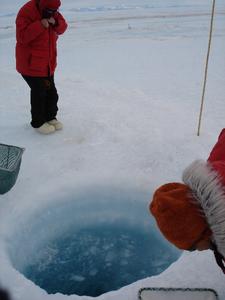
1. The ice is cleared from the saftey hole before diving begins.
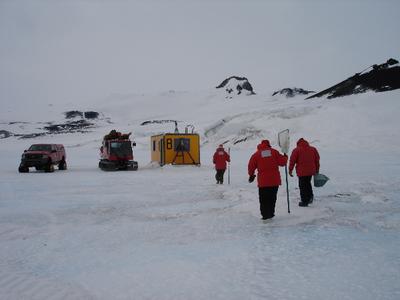
2. The scene at Cinder Cones: the Mattrack, Pisten Bully, dive hut, and dive tenders. The large rock in the background is called Castle Rock.
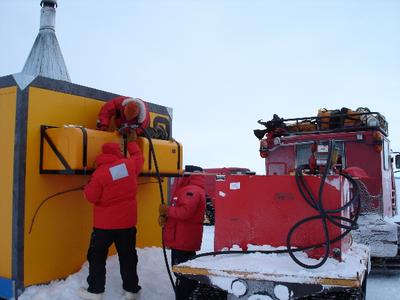
3. Fueling the tanks for the dive hut stove from the fuel sledge. Stacy had to go out through the roof to access the tanks.
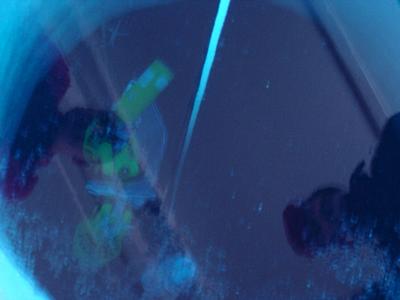
4. You can just see the sea star (two legs are together, so it looks as though they have only four) at the top of the picture. The sea star is 60 feet down in the water.
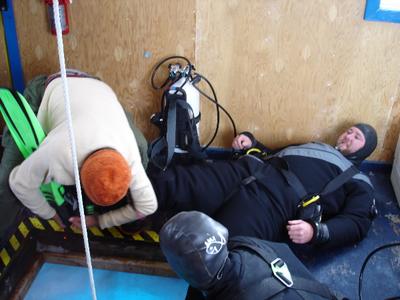
5. Getting into dive gear is an awkward process and requires help for some parts. Here, Mike gets a hand with his fins.

6. Bob Zook relaxes and removes his fins at the end of a dive.

7. The underwater housing for the video camera. One the bottom are lasers that are used to get an accurate scale, or way to tell how big things really are in the video image.
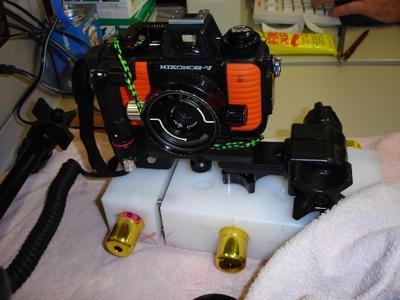
8. A Nikonos underwater camera.
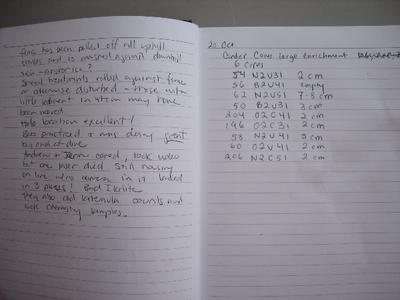
9. Dr. Stacy Kim's ASPIRE project notebook. On the left are comments and notes on the day's work. On the right is a record of which samples from the Cinder Cones dive site were sieved.
Contact the TEA in the field at
.
If you cannot connect through your browser, copy the
TEA's e-mail address in the "To:" line of
your favorite e-mail package.
|
